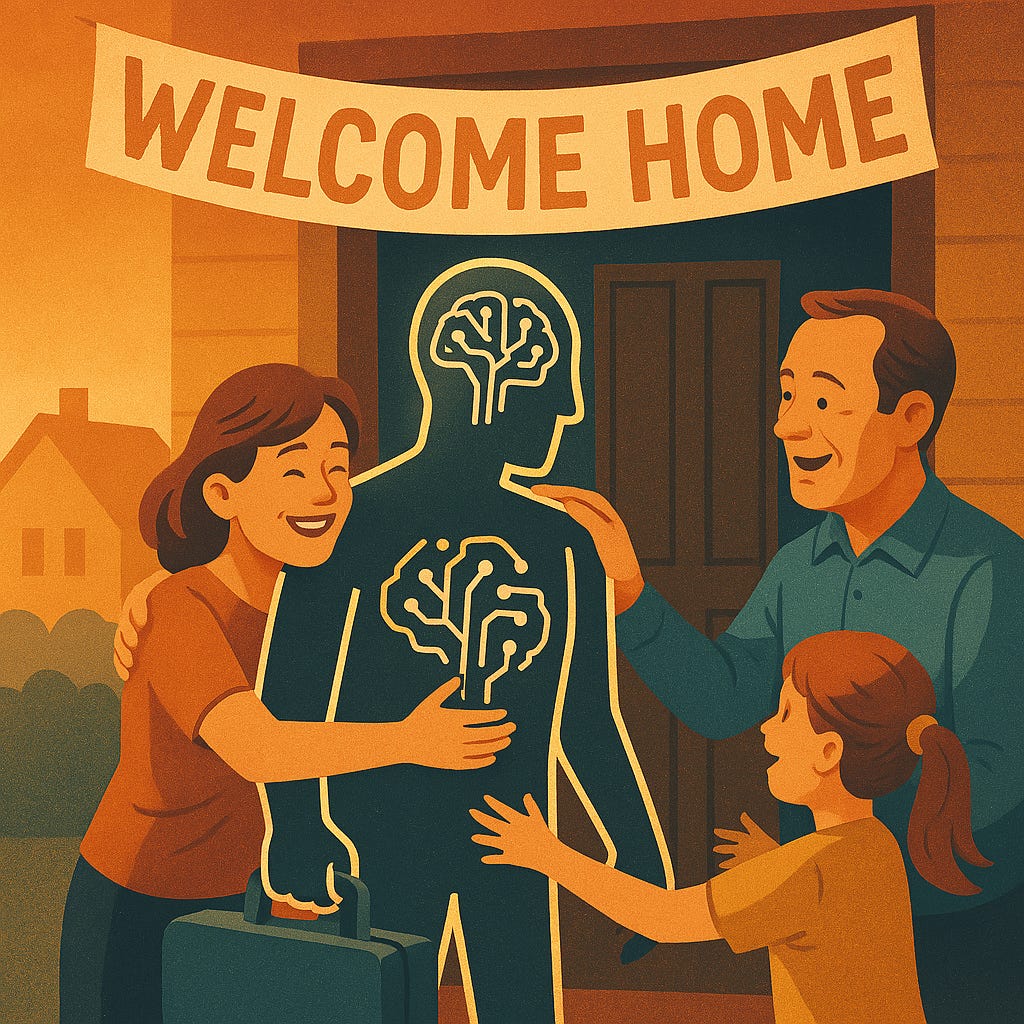The AI Homecoming: How Processing Power Returns to Where We Live and Work
Why the future of artificial intelligence isn't in the cloud
Something remarkable is happening in the world of artificial intelligence.
After years of sending our data to distant servers for processing, AI is coming home. The most sophisticated AI models are now small enough to run entirely on the devices we carry in our pockets, sit at our desks, and drive to work.
This shift represents more than a technical evolution.
It signals a fundamental reimagining of how we interact with intelligent systems in our Digital Realities.
The Technical Breakthrough That Changes Everything
Think of AI ideas (or parameters) like the number of facts and patterns an AI can remember and use to make decisions. A year ago, the smartest AI models needed to remember hundreds of billions of these facts, requiring massive data centers. Today's breakthrough models can be just as smart while remembering only a few billion facts, small enough to fit in your smartphone.
This transformation comes from a technique called distillation, where large AI models essentially teach smaller ones.
The results are startling. New models like DeepSeek R1 match the performance of cloud-based giants while running entirely on local devices. Over 75% of major AI models released in 2024 achieved this remarkable compression.
When I wrote about "The Coming PC and Smartphone War" last year, I forecasted that mobile devices would become the catalyst for bringing AI processing power directly to users. Samsung's new Galaxy Fold series exemplifies this forecast.
Watch a user unfold their phone into a tablet, and you're seeing the future of personal AI computing.
The Business Case for Local Intelligence
The economic implications extend far beyond hardware specifications. Organizations are discovering that on-premises AI processing delivers compelling advantages across multiple dimensions:
Cost Efficiency: Companies can eliminate ongoing cloud inference fees while achieving faster response times. Meta's new approach allows businesses to download and customize AI models for their specific needs, then run them entirely on their own computers instead of paying recurring cloud costs. Early adopters report reducing AI operating expenses by up to 70%.
Data Sovereignty: High-security sectors are driving adoption through necessity. Precise Biometrics recently launched fully on-premises biometric access control systems for defense and critical infrastructure. These organizations need AI capabilities but cannot risk data exposure through cloud processing. Local AI gives them both intelligence and control.
Performance Advantages: On-device processing eliminates the 100-300 millisecond delays inherent in cloud-based systems. For applications requiring real-time responses, whether in autonomous vehicles or industrial IoT, this latency reduction can be the difference between success and failure.
A New Digital Infrastructure Emerges
This transformation is creating entirely new product categories. Qualcomm's latest networking platforms turn ordinary Wi-Fi routers into "private, local AI-based mini-servers" within homes and enterprises. Your router becomes an intelligent hub that processes data for all connected devices without external dependencies.
The automotive sector illustrates how this local intelligence enables new possibilities. Advanced driver assistance systems now use on-device AI for real-time decision-making in safety-critical situations. These systems cannot depend on cloud connectivity when milliseconds matter for collision avoidance.
The Path Forward
Organizations preparing for this AI homecoming should consider three strategic imperatives:
First, evaluate which processes require real-time intelligence and data sovereignty. These represent the highest-value applications for local AI deployment.
Second, develop hybrid architectures that combine on-premises intelligence with cloud-based training and updates. The future isn't purely local or purely cloud, but intelligently distributed.
Third, invest in edge infrastructure capabilities. Whether through specialized hardware, local processing platforms, or intelligent networking equipment, building local AI capacity becomes a competitive advantage.
A Return to Hopeful Futures
The robots and AI assistants that captured our imagination (from Star Trek's Data to R2-D2 to Tony Stark's FRIDAY) all shared one crucial characteristic: they thought for themselves while enhancing human capabilities.
They weren't mindless extensions of some distant computer brain; they were independent partners who understood their human companions' unique needs and context.
Today's shift to local AI processing brings us closer to that hopeful vision. Your smartphone, your car, your home office are all learning to think locally, to understand your specific patterns and preferences, to respond instantly to your needs without checking with some distant digital overlord.
This isn't about replacing human intelligence; it's about giving every person access to a thoughtful, responsive digital companion that makes daily challenges easier to solve.
Imagine AI that learns your morning routine and quietly optimizes your schedule. Picture technology that adapts to your communication style, anticipates your information needs, and respects your privacy by keeping your personal data exactly where it belongs: with you.
The AI homecoming represents something deeper than technological advancement. It signals a return to human-centered innovation, where intelligence serves proximity rather than surveillance, where responsiveness trumps data extraction, and where the future feels less like submission to algorithmic overlords and more like partnership with digital allies.
We stand at the threshold of an era where every surface, every device, every space can host intelligence that genuinely understands context, respects boundaries, and enhances human potential.
This distributed intelligence doesn't seek to control or predict us; it seeks to support and amplify our capabilities.
In this future, AI doesn't watch us from the cloud.
It works alongside us, right where we are, understanding our world because it lives in our world.
That partnership between humans and technology that the best science fiction always promised us?
It's not coming someday. It's coming home today.





Great article Rich. I'm looking at my router in a new way!